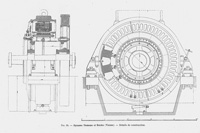Use of Electric Energy
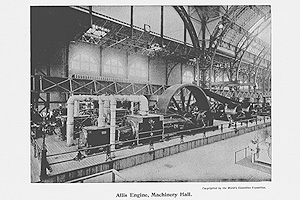 This is an image of an Allis Engine, a steam engine exhibited at the Electricity Building of the Chicago International Exposition of 1893. This engine operated a dynamo to generate electricity and supply it to the exposition venues. A wide variety of inventions using electricity were exhibited at this international event, demonstrating that the age of electricity had arrived. (Column: Use of Electricity)
This is an image of an Allis Engine, a steam engine exhibited at the Electricity Building of the Chicago International Exposition of 1893. This engine operated a dynamo to generate electricity and supply it to the exposition venues. A wide variety of inventions using electricity were exhibited at this international event, demonstrating that the age of electricity had arrived. (Column: Use of Electricity)
Prior to the 18th century, "electricity" meant static electricity generated by friction. In 1800, A. Volta discovered the phenomenon of the generation of electricity through the contact of dissimilar metals through solutions, and invented the Voltaic Pile (electric battery), enabling continuous generation of an electric current. After a while, his invention was improved by W. Cruikshank into a practical battery.
In 1821, M. Faraday devised the principle of electric motor for the first time. This was based on the phenomenon of the generation of a force when a wire carrying electric current was brought close to a magnet. In 1831, he also announced the Law of the Electro-magnetic Induction, which stated that electricity was generated when a permanent magnet was slid in and out of a coil of iron wires, namely that electricity could be generated by magnetism. All dynamos and transformers today follow the application of this law. In 1832, applying this law, H. Pixii invented the world's first dynamo. While both motors and dynamos used the same principle, the former operated machines with electric energy and the latter generated electric energy with torque produced by the operation of machines.
Around the 1860s, the demand for electricity was increased with the practical use of arc lamps, the development of telegraphs and other factors. This was followed by successive productions of practical dynamos, such as those by W. von Siemens and Z. T. Gramme. In 1882, Holborn Viaduct began to be operated in the United Kingdom as the world's first electricity generating station for the general consuming public. Meanwhile, motors began to be put into practical use in the 1870s, a little later than the dynamo. At the Vienna International Exposition of 1873, Gramme exhibited a direct current motor. The mainstream of electricity technology in those days was direct current. However, the late 1880s and subsequent years witnessed the rise of alternating current, as demonstrated by the invention of the two-phase alternating current motor by G. Ferraris, the employment of an alternating current system by Westinghouse Co., and the construction of an alternating current power generating station by S. Z. de Feranti. Along with this movement, the development of an alternating current motor was awaited. In 1887, N. Tesla invented a practical alternating current motor (a two-phase induction motor).
The invention of dynamos and their subsequent improvements enabled the supply of electricity in large amounts, spurring the development of electric lamps and motors, as well as telegraphs and telephones. Also, electricity began to be used for a wide range of items, such as once manually-operated agricultural implements and other daily devices. A substantial change of power form from steam to electricity was achieved in the late 19th century, as indicated particularly by the electric operation of locomotives that had previously been powered by steam. Additionally, efforts were made to use electricity for various other items, such as medical and daily devices.
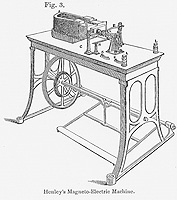
Magneto-electric machine using a Voltaic battery
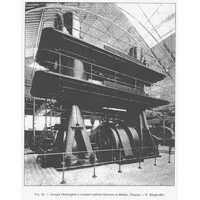
Siemens & Halske's Direct Current Electricity Generation Machine
Elevator
Although it might sound a little surprising, elevators have a long history. At the beginning of the 19th century, an elevator making use of water pressure had already been developed. At the New York International Exposition of 1853, Otis' elevator powered by steam was exhibited. It was said that E. G. Otis himself gave a demonstration for the safety of the elevator. At the second Paris International Exposition of 1867, a hydraulic elevator was exhibited. This is an image of the elevator installed at the Chicago International Exposition of 1893. At the exposition, which presented the supremacy of electricity, the elevator was operated by electricity.
Steam Engine for Electricity Generation (3 images)
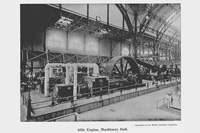 |
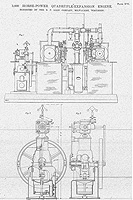 |
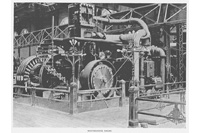 |
| Allis Engine (Steam Engine for Electricity Generation) |
Structural Drawings of Allis Engine (Steam Engine for Electricity Generation) |
Westinghouse's Steam Engine for Electricity Generation |
Elevator (4 images)
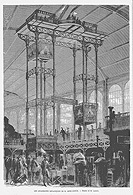 |
 |
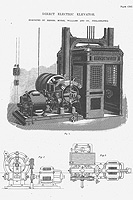 |
| L. Edoux's Hydraulic Elevator | Elevator Made by Otis Co. | Morse & Williams' Elevator |
- References:
Iwamoto, Hiroshi.: E demiru denki no rekishi: Zuhan 300mai de monogataru denki no hakken no tabi (Omusha, 2003) <ND21-H5>
Kisaka, Shunkichi.: Erekutoronikusu o chushin toshita nendaibetsu kagaku gijutsushi 5th ed. (Nikkan kogyo shinbunsha, 2001) <M31-G50>
Naokawa, Kazuya.: Denki no rekishi (Tokyo denki daigaku shuppankyoku, 1994) <ND21-E48>
Singer, Charles Joseph (et al) (ed); Takagi, Junichi (tr. and ed.).: Gijutsu no rekishi 9 Enlarged ed. (Chikuma shobo, 1979) <M31-47>
Takahashi, Yuzo.: Hyakumannin no denki gijutsushi (Kogyo chosakai, 2006) <ND21-H140>


